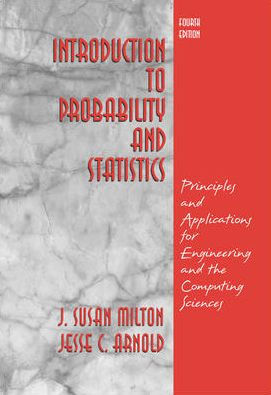Table of Contents
1 Introduction to Probability and Counting
1.1 Interpreting Probabilities
1.2 Sample Spaces and Events
1.3 Permutations and Combinations
2 Some Probability Laws
2.1 Axioms of Probability
2.2 Conditional Probability
2.3 Independence and the Multiplication Rule
2.4 Bayes' Theorem3 Discrete Distributions
3.1 Random Variables
3.2 Discrete Probablility Densities
3.3 Expectation and Distribution Parameters
3.4 Geometric Distribution and the Moment Generating Function
3.5 Binomial Distribution
3.6 Negative Binomial Distribution
3.7 Hypergeometric Distribution
3.8 Poisson Distribution4 Continuous Distributions
4.1 Continuous Densities
4.2 Expectation and Distribution Parameters
4.3 Gamma Distribution
4.4 Normal Distribution
4.5 Normal Probability Rule and Chebyshev's Inequality
4.6 Normal Approximation to the Binomial Distribution
4.7 Weibull Distribution and Reliability
4.8 Transformation of Variables
4.9 Simulating a Continuous Distribution5 Joint Distributions
5.1 Joint Densities and Independence
5.2 Expectation and Covariance
5.3 Correlation
5.4 Conditional Densities and Regression
5.5 Transformation of Variables6 Descriptive Statistics
6.1 Random Sampling
6.2 Picturing the Distribution
6.3 Sample Statistics
6.4 Boxplots7 Estimation
7.1 Point Estimation
7.2 The Method of Moments and Maximum Likelihood
7.3 Functions of Random Variables--Distribution of X
7.4 Interval Estimation and the Central Limit Theorem8 Inferences on the Mean and Variance of a Distribution
8.1 Interval Estimation of Variability
8.2 Estimating the Mean and the Student-t Distribution
8.3 Hypothesis Testing
8.4 Significance Testing
8.5 Hypothesis and Significance Tests on the Mean
8.6 Hypothesis Tests
8.7 Alternative Nonparametric Methods9 Inferences on Proportions
9.1 Estimating Proportions
9.2 Testing Hypothesis on a Proportion
9.3 Comparing Two Proportions: Estimation
9.4 Coparing Two Proportions: Hypothesis Testing10 Comparing Two Means and Two Variances
10.1 Point Estimation
10.2 Comparing Variances: The F Distribution
10.3 Comparing Means: Variances Equal (Pooled Test)
10.4 Comparing Means: Variances Unequal
10.5 Compairing Means: Paried Data
10.6 Alternative Nonparametric Methods
10.7 A Note on Technology11 Sample Linear Regression and Correlation
11.1 Model and Parameter Estimation
11.2 Properties of Least-Squares Estimators
11.3 Confidence Interval Estimation and Hypothesis Testing
11.4 Repeated Measurements and Lack of Fit
11.5 Residual Analysis
11.6 Correlation12 Multiple Linear Regression Models
12.1 Least-Squares Procedures for Model Fitting
12.2 A Matrix Approach to Least Squares
12.3 Properties of the Least-Squares Estimators
12.4 Interval Estimation
12.5 Testing Hypotheses about Model Parameters
12.6 Use of Indicator or "Dummy" Variables
12.7 Criteria for Variable Selection
12.8 Model Transformation and Concluding Remarks13 Analysis of Variance
13.1 One-Way Classification Fixed-Effects Model
13.2 Comparing Variances
13.3 Pairwise Comparison
13.4 Testing Contrasts
13.5 Randomized Complete Block Design
13.6 Latin Squares
13.7 Random-Effects Models
13.8 Design Models in Matrix Form
13.9 Alternative Nonparametric Methods14 Factorial Experiments
14.1 Two-Factor Analysis of Variance
14.2 Extension to Three Factors
14.3 Random and Mixed Model Factorial Experiments
14.4 2^k Factorial Experiments
14.5 2^k Factorial Experiments in an Incomplete Block Design
14.6 Fractional Factorial Experiments15 Categorical Data
15.1 Multinomial Distribution
15.2 Chi-Squared Goodness of Fit Tests
15.3 Testing for Independence
15.4 Comparing Proportions16 Statistical Quality Control
16.1 Properties of Control Charts
16.2 Shewart Control Charts for Measurements
16.3 Shewart Control Charts for Attributes
16.4 Tolerance Limits
16.5 Acceptance Sampling
16.6 Two-Stage Acceptance Sampling
16.7 Extensions in Quality Control
Appendix A Statistical Tables
Appendix B Answers to Selected Problems
Appendix C Selected Derivations







